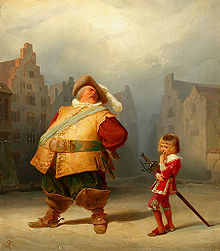Our website is made possible by displaying online advertisements to our visitors.
Please consider supporting us by disabling your ad blocker.
John Falstaff
| John Falstaff | |
|---|---|
| Henriad character | |
 Adolf Schrödter: Falstaff and his page | |
| Created by | William Shakespeare |
| In-universe information | |
| Gender | Male |
| Occupation | Knight |
| Religion | Christian |
| Nationality | English |
Sir John Falstaff is a fictional character who appears in three plays by William Shakespeare and is eulogised in a fourth. His significance as a fully developed character is primarily formed in the plays Henry IV, Part 1 and Part 2, where he is a companion to Prince Hal, the future King Henry V of England. Falstaff is also featured as the buffoonish suitor of two married women in The Merry Wives of Windsor. Though primarily a comic figure, he embodies a depth common to Shakespeare's major characters. A fat, vain, and boastful knight, he spends most of his time drinking at the Boar's Head Inn with petty criminals, living on stolen or borrowed money. Falstaff leads the apparently wayward Prince Hal into trouble, and is repudiated when Hal becomes king.
Falstaff has appeared in other works, including operas by Giuseppe Verdi, Ralph Vaughan Williams, and Otto Nicolai, a "symphonic study" by Edward Elgar, and in Orson Welles's 1966 film Chimes at Midnight. The operas focus on his role in The Merry Wives of Windsor, while the film adapts the Henriad and The Merry Wives. Welles, who played Falstaff in his film, considered the character "Shakespeare's greatest creation".[1] The word "Falstaffian" has entered the English language with connotations of corpulence, jollity, and debauchery.[2]
- ^ Lyons 1989, p. 4.
- ^ McMahon 2004, p. 18.
Previous Page Next Page


